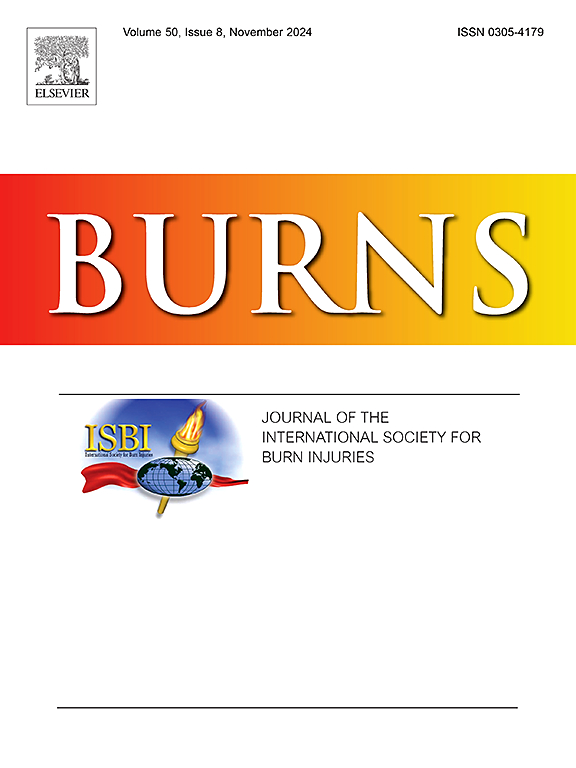Kitchen cooking burns: A real danger for adults and children in Ghana
IF 3.2
3区 医学
Q2 CRITICAL CARE MEDICINE
引用次数: 0
Abstract
Background
In many low- and middle-income countries (LMICs), stove and fuel stacking are frequent practices. However, the impact of stacking on health, particularly cooking-related burns (CRBs), is unknown. This study aims to examine the prevalence and severity of CRBs and to identify associated household factors. Emphasis was placed on cooking behaviors and practices (i.e., fuel choice and stacking) that influence CRBs.
Methods
This study is a baseline for the Briquette for Cooking Fuel Project (B4CcokingF), a cluster randomized controlled trial in riparian communities in southern Ghana. The baseline data collection started in June 2019 and ended in October 2022. To start with, trained field workers, led by a community representative, visited eligible households (HHs) in each community and conducted interviews with a structured questionnaire. 420 primary cooks age between 25 and 68 years were interviewed on cooking behaviour and practices as well as cooking-related burns and injuries using a slightly modified, well-established, and validated World Health Organization (WHO)-harmonized questionnaire to monitor household energy use and Sustainable Development Goals (SDG) indicators 7.1.1 and 7.1.2.
Results
CRBs were prevalent in 31.8 % of adult primary cooks. The majority of moderate and severe CRBs—roughly 61 % and 27 %, respectively—occurred in the kitchen by contact with a hot stove. Belonging to a middle wealth index status was protective against CRBs in adults but having more than 10 people in a HH was a significant risk factor of adult CRBs. A unit increase in the number of rooms in a HH was associated with a 43 % increase in the risk of CRBs in adults. Approximately 16 % of children suffer from CRBs, and 64 % sustain severe burns, with the majority of these incidents occurring in the kitchen at home. A HH having a family size of 6–10 was positively associated with CRBs, but using an LPG cookstove was protective in children. Mixed stacking defined as stacking LPG with polluting fuel (PR=2.10, 95 %, confidence interval (CI): 1.12, 3.94) was associated with CRBs in children but not adults.
Conclusion
Factors associated with adult CRBs include middle wealth index status, the number of rooms in a household, and having more than 10 people in a household. Having a family size of 6–10 and the use of LPG by the HH were associated with child CRB risk. Mixed stacking is associated with CRBs in children, but the findings among adult cooks were inconclusive. The children population is disproportionately affected; therefore, it is essential to develop and execute customized preventative initiatives that cater to their specific vulnerabilities. The paramount objective of Ghana's initiatives to enhance access to liquefied petroleum gas should be the assurance of safe usage.
求助全文
约1分钟内获得全文
求助全文
来源期刊

Burns
医学-皮肤病学
CiteScore
4.50
自引率
18.50%
发文量
304
审稿时长
72 days
期刊介绍:
Burns aims to foster the exchange of information among all engaged in preventing and treating the effects of burns. The journal focuses on clinical, scientific and social aspects of these injuries and covers the prevention of the injury, the epidemiology of such injuries and all aspects of treatment including development of new techniques and technologies and verification of existing ones. Regular features include clinical and scientific papers, state of the art reviews and descriptions of burn-care in practice.
Topics covered by Burns include: the effects of smoke on man and animals, their tissues and cells; the responses to and treatment of patients and animals with chemical injuries to the skin; the biological and clinical effects of cold injuries; surgical techniques which are, or may be relevant to the treatment of burned patients during the acute or reconstructive phase following injury; well controlled laboratory studies of the effectiveness of anti-microbial agents on infection and new materials on scarring and healing; inflammatory responses to injury, effectiveness of related agents and other compounds used to modify the physiological and cellular responses to the injury; experimental studies of burns and the outcome of burn wound healing; regenerative medicine concerning the skin.
 求助内容:
求助内容: 应助结果提醒方式:
应助结果提醒方式:


